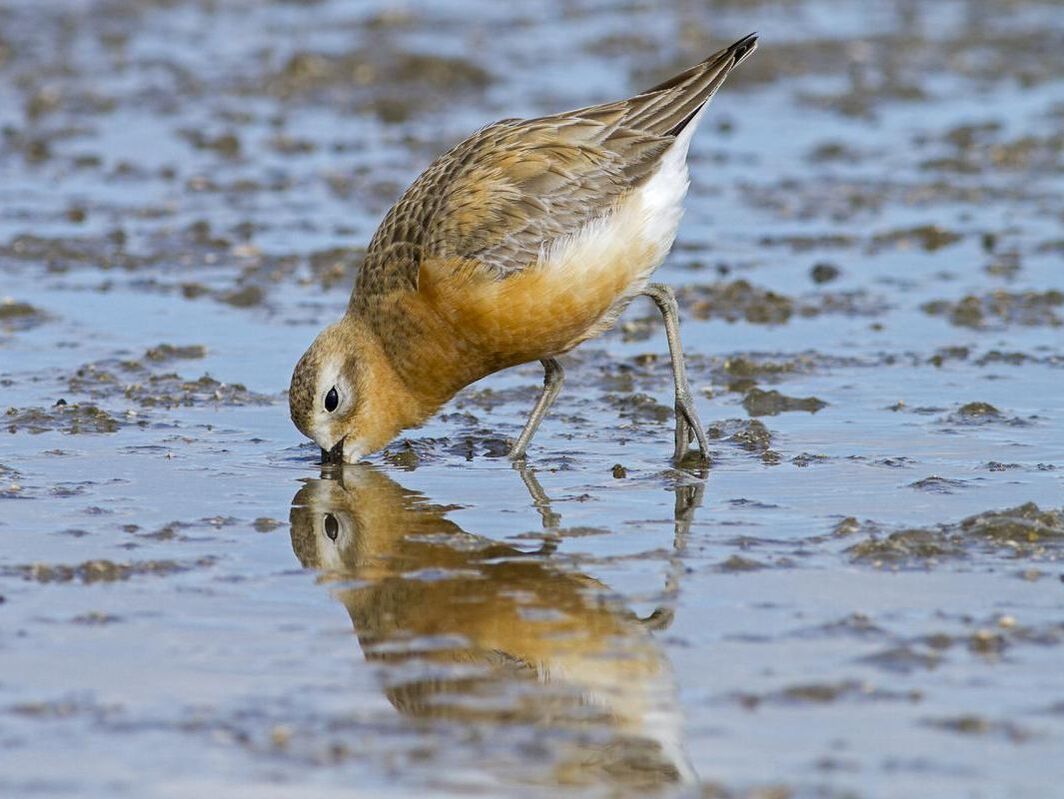Where will you see the NZ dotterel?
The New Zealand dotterel is a familiar bird of sandy east coast beaches in the northern North Island, but is sparsely distributed around much of the rest of the country. There are two widely separated subspecies: the northern New Zealand dotterel is more numerous, and breeds around the North Island; the southern New Zealand dotterel was formerly widespread in the South Island, and now breeds only on Stewart Island. Southern New Zealand dotterels are larger, heavier, and darker than northern New Zealand dotterels.Source:
NZ birds online

New Zealand dotterel. Northern subspecies non-breeding adult. Miranda, Firth of Thames, February 2009. Image © Neil Fitzgerald by Neil Fitzgerald www.neilfitzgeraldphoto.co.nz
|

New Zealand dotterel. Adult northern subspecies in breeding plumage eating beetle. Opoutere Wildlife Refuge Reserve, Coromandel Peninsula, July 2008. Image © Neil Fitzgerald by Neil Fitzgerald www.neilfitzgeraldphoto.co.nz
|

New Zealand dotterel. Southern subspecies adult on breeding grounds showing camouflage. Hill west of South Arm, Port Pegasus, Stewart Island, October 1969. Image © Department of Conservation (image ref: 10035557) by Don Merton, Department of Conservation Courtesy of Department of Conservation
|

New Zealand dotterel. Southern subspecies adult male displaying on breeding grounds. West of South Arm, Port Pegasus, Stewart Island, October 1969. Image © Department of Conservation (image ref: 10031565) by Don Merton, Department of Conservation Courtesy of Department of Conservation
|
Habitat
There are major differences in breeding habitat between the two subspecies. Northern birds mainly breed on sandy beaches and sandspits, some on shell banks in harbours, a few on gravel beaches. On beaches, they are usually clustered around stream-mouths. In urban areas (particularly Auckland) they often breed a short distance inland on short grass (golf courses, motorway verges, beside airport runways) or on bare ground (building sites, quarries). Southern birds breed on exposed subalpine herbfields and rocky areas above the tree-line on Stewart Island, but are coastal during the non-breeding season, feeding on inter-tidal mudflats and beaches.Source:
NZ birds online

New Zealand dotterel. Nest with 3 eggs. Karaka shellbank, Manukau Harbour, December 1984. Image © Alan Tennyson by Alan Tennyson
|

New Zealand dotterel. Nest with one egg in pasture. Ambury Regional Park, Auckland, September 2014. Image © Jacqui Geux by Jacqui Geux
|

New Zealand dotterel. Nest and eggs. Hot Water Beach, Coromandel. Image © Noel Knight by Noel Knight
|

New Zealand dotterel. Adult southern New Zealand dotterel on breeding grounds. Hill west of South Arm, Port Pegasus, Stewart Island, October 1968. Image © Department of Conservation (image ref: 10031567) by Don Merton, Department of Conservation Courtesy of Department of Conservation
|
The dotterel is also known as a plover
Plovers (/ˈplʌvər/ or /ˈploʊvər/) are a widely distributed group of wading birds belonging to the subfamily Charadriinae.
There are about 66 species in the subfamily, most of them called “plover” or “dotterel”.
Plovers are found throughout the world, with the exception of the Sahara and the polar regions, and are characterised by relatively short bills. They hunt by sight, rather than by feel as longer-billed waders like snipes do. They feed mainly on insects, worms or other invertebrates, depending on the habitat, which are obtained by a run-and-pause technique, rather than the steady probing of some other wader groups.
Plovers engage in false brooding, a type of distraction display. Examples include: pretending to change position or to sit on an imaginary nest site.
A group of plovers may be referred to as a stand, wing, or congregation. A group of dotterels may be referred to as a trip.
Source:
Wikipedia

New Zealand dotterel. Male of the northern subspecies in breeding plumage, foraging.. Ambury Regional Park, August 2014. Image © Bruce Buckman by Bruce Buckman https://www.flickr.com/photos/brunonz/
|

New Zealand dotterel. Adult performing a distraction display. Pakiri Beach, November 2009. Image © Neil Fitzgerald by Neil Fitzgerald www.neilfitzgeraldphoto.co.nz
|
The New Zealand plover (Charadrius obscurus) is a species of shorebird found only in certain areas of New Zealand. Its Māori names include tūturiwhatu, pukunui, and kūkuruatu.
[…]
Other common names for the New Zealand plover include the red-breasted dotterel and the New Zealand dotterel.Source:
Wikipedia
Drawing the Southern NZ dotterel sub-species
Structurally, they seem very similar, certainly at the level of detail that I will be showing in my drawings.
They do have different colouring, though.

New Zealand dotterel. Immature southern sub-species. Awarua Bay, June 2007. Image © Paul Sorrell by Paul Sorrell
|

New Zealand dotterel. Northern subspecies pair in courtship display. Coromandel Peninsula, July 2008. Image © Neil Fitzgerald by Neil Fitzgerald www.neilfitzgeraldphoto.co.nz
|
A bulky plover with a heavy black bill, relatively long grey legs and large round dark eyes.
The upperparts are brown, darker in the southern subspecies, and the underparts are off-white in autumn-early winter, becoming orange-red (also darker in southern birds) from about May onwards. The depth and extent of red colour varies individually and seasonally, but males are generally darker than females. The bill is heavy and black, and the legs mid-grey. First-winter birds have pure white underparts, with legs yellowish to pale grey.
Source:
NZ Birds online
Sketches
As usual, I capture my palette and use green to identify the uncoloured areas.
And it’s all done!
























